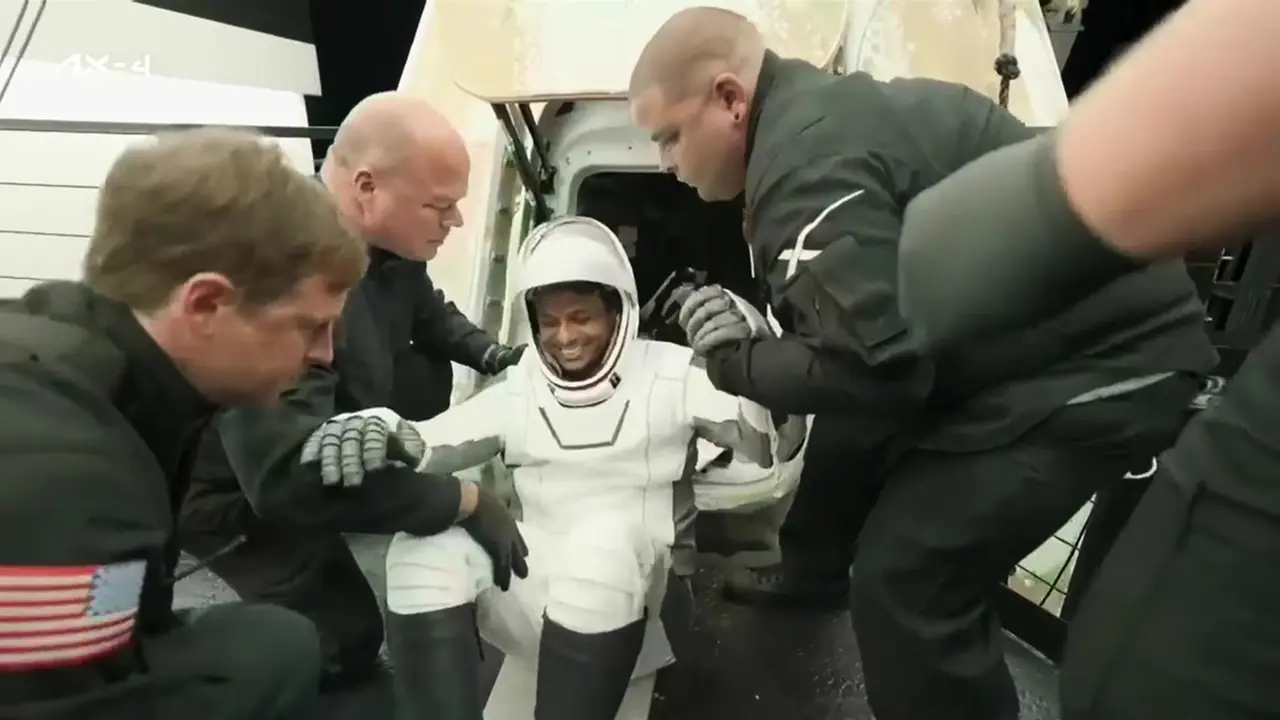Axiom Mission 4 (Ax-4) marked a milestone in commercial spaceflight, with Indian astronaut Shubhanshu Shukla and crewmates from four nations conducting groundbreaking biomedical, agricultural, and AI research aboard the ISS.
Axiom Mission 4 (Ax-4) marked a pivotal moment in commercial space exploration. Conducted in June/July -2025, the mission brought together astronauts from the United States, India, Poland, and Hungary. Their 18-day stay aboard the International Space Station (ISS) was more than a demonstration of international cooperation. It was a powerful expression of science in motion, featuring over 60 experiments spanning life sciences, biotechnology, physical sciences, materials, agriculture, and advanced computing.

The mission concluded with the successful return of the SpaceX Dragon capsule Grace, which splashed down gently in the Pacific Ocean off the coast of California on July 15. The safe landing marked the culmination of a flawlessly executed mission, showcasing not only scientific achievement but also the precision, discipline, and international coordination that modern spaceflight demands. It was a powerful testimony to human ingenuity and the growing capabilities of commercial space operations.
What makes Ax-4 particularly groundbreaking is that it was conceived and operated by a private space company. Axiom Space, leading the charge in commercial human spaceflight, is redefining access to orbital research. Through missions like Ax-4, companies are no longer just launch providers but are becoming full-fledged facilitators of scientific progress, fostering innovation at a pace and scale once limited to government agencies.
Biomedical Studies: Protecting Human Health in Space and on Earth
Ax-4’s medical experiments aimed to address the risks astronauts face in microgravity and to improve health care on Earth. Blood samples were collected to study changes in glucose metabolism, muscle degeneration, and bone density loss. Continuous glucose monitors and insulin pens were tested for their reliability in space. These findings may help develop better treatments for diabetes, osteoporosis, and other metabolic conditions.
The mission also explored muscle regeneration and neurocognitive responses. Indian researchers examined how microgravity affects muscle stem cells, while Polish scientists evaluated the psychological impact of space isolation using neurofeedback and EEG-based monitoring. These studies support astronaut wellness and could influence therapies for mental health disorders and age-related muscular decline.
Plant Growth and Space Farming
Sustainable space habitation depends on the ability to grow food in microgravity. Ax-4 researchers tackled this challenge by germinating fenugreek and moong bean seeds aboard the ISS. The Indian Space Research Organisation (ISRO) led this experiment to better understand how seed orientation, nutrient delivery, and light exposure influence plant growth in orbit.
Scientists also studied cyanobacteria in space to determine whether urea or nitrogen-based nutrients promote better growth. Microalgae were examined for their potential as oxygen generators, food sources, and future biofuel options in long-duration missions.
Tiny Organisms, Big Discoveries
Tardigrades, also known as water bears, featured prominently in Ax-4 biology experiments. Their extraordinary ability to survive radiation, dehydration, and microgravity makes them ideal models for understanding life in extreme environments. Researchers observed how these organisms reproduce and express genes in space, offering insight into biological resilience.
Polish teams also sent engineered yeast strains containing tardigrade genes to assess viability and protein production. The goal was to explore microbial biotechnology for future use in orbiting bio-manufacturing systems.
Cutting-Edge Materials and Medical Delivery Systems
Polish investigators examined polymer-based drug delivery systems engineered to release medication gradually under varying environmental conditions. These systems were tested for stability in radiation and microgravity, with implications for patient care on Earth and in space.
Nanomaterials like MXene were also evaluated for use in flexible wearable health sensors. These materials are electrically conductive and lightweight, making them suitable for real-time astronaut monitoring and next-generation clinical devices.
Artificial Intelligence and Smart Systems
Poland introduced an edge computing unit named Leopard, which processed scientific data directly aboard the station. This capability is especially relevant for future missions to the Moon or Mars, where communication delays may impact real-time decisions.
India’s Voyager Displays experiment studied how astronauts interact with touch-screen interfaces under microgravity. The research measured pointing accuracy, memory retention, and mental strain, with the aim of improving interface design for future crewed spacecraft.
Educational Outreach and Global Inspiration
The Ax-4 crew engaged in extensive public outreach through amateur radio conversations and live classroom broadcasts. Indian astronaut Shubhanshu Shukla spoke directly to students and ISRO officials from the ISS, creating a moment of pride and scientific curiosity for Indian space enthusiasts.
These interactions encouraged broader global participation in space exploration and highlighted the growing accessibility of research in orbit, especially for countries joining the ISS ecosystem for the first time.
The Broader Impact
The Ax-4 mission showed that meaningful, high-impact science can be conducted by private astronauts in low-Earth orbit. It also reaffirmed the role of commercial missions in enabling global collaboration, diversifying participation, and expanding the scientific value of the ISS.
Through its focus on human physiology, sustainable agriculture, materials innovation, and computing autonomy, the Ax-4 mission advanced the case for long-term human presence in space. Its findings may enhance life on Earth while laying the foundation for future space stations, lunar bases, and Mars expeditions.
In essence, Axiom Mission 4 was not just a voyage to the ISS. It was a flying laboratory of discovery that pushed the boundaries of space science and international cooperation. It also underscored a broader shift: the future of space exploration will be shaped not only by nations but by pioneering companies that are opening the cosmos to science, commerce, and humanity as never before.


